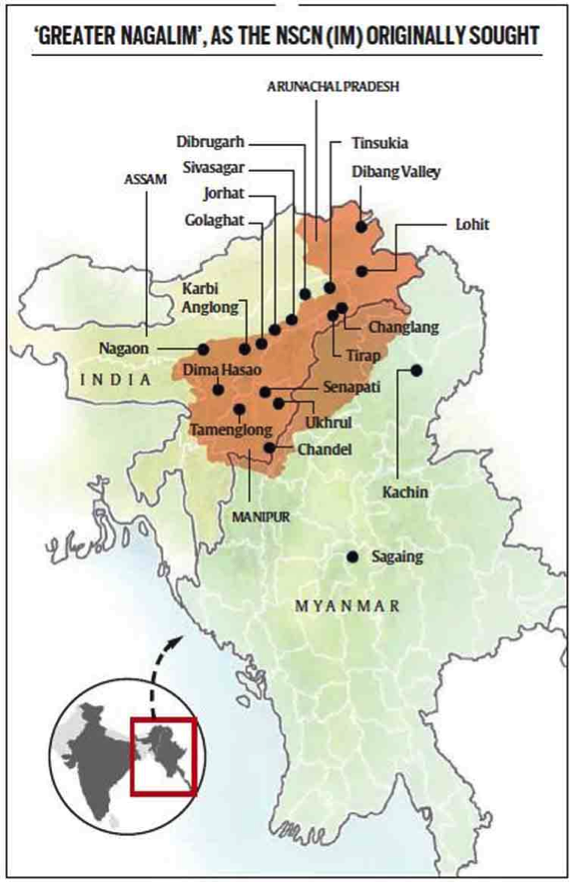Basic demands of Nagas:
Basic demand of Nagas is to form a pan-naga territorial state carving out regions from Nagaland, Manipur and Arunachal Pradesh. They call it “Greater Nagaland” or “Nagalim”.

Timeline:
The Naga insurgency, rooted in Naga nationalism, is one of the oldest insurgencies in the country.
-
Naga independence declared: The Naga-inhabited areas of the Northeast never considered themselves part of British India, and on August 14, 1947, the Naga National Council (NNC) led by Angami Zapu Phizo declared independence for Nagaland.
-
AFSPA enacted: Phizo formed an underground Naga Federal Government (NFG) and a Naga Federal Army (NFA) in 1952, in response to which the Centre sent in the Army and enacted the Armed Forces (Special) Powers Act, or AFSPA.
-
Shillong accord signed: After years of talks, the Shillong Accord was signed in 1976 with underground groups of Nagaland, but it was rejected by many top NNC leaders. They argued that it didn’t address the issue of Naga sovereignty and forced Nagas to accept the Indian Constitution.
-
Split in NNC: Five years later, Isak Chishi Swu, Thuingaleng Muivah, and S S Khaplang split from the NNC and formed the NSCN to continue the armed struggle.
-
Split in NSCN: In 1988, the NSCN split again into NSCN(IM) led by Isak and Muivah and NSCN(K) led by Khaplang. The NSCN(IM) is dominated by the Tangkhul tribe of Ukhrul, Manipur (to which Muivah belongs) and the Sema tribe (from which Isak hailed) of Nagaland.
-
NSCN(IM) enters into a ceasefire: In 1997, the NSCN(IM) entered into a ceasefire with the Indian government, which gave rise to hope for a final settlement. There have been nearly 100 rounds of talks since then.
-
Framework agreement concluded: In August 2015, the group signed a framework agreement with the Indian government for the Naga Peace Accord. Ravi was appointed interlocutor to take the talks to their conclusion. But while both the government and Naga groups said the talks successfully concluded on the government’s deadline of October 31, 2019, no accord was signed.
-
Agreement signed with NNPGs: In November 2017, Ravi signed an agreement with seven groups who had come together under the banner of the Naga National Political Groups (NNPGs), which did not include the NSCN (IM). The IM, which considers itself the principal representative of Naga aspirations, has been a rival of many of the NNPG groups. In a letter to Prime Minister Narendra Modi in 2020, the IM accused Ravi of attempting to “segregate the Naga civil society”.
-
Ravi expresses frustration over the delay: After becoming Nagaland Governor in 2019, Ravi expressed frustration at the delay in concluding the deal. He wrote a scathing letter to Chief Minister Neiphiu Rio, calling the NSCN(IM) an “armed gang”, and accused it of running a “parallel government” and engaging in extortion.
-
In response, the NSCN(IM) hardened its position, saying the Naga flag and constitution were non-negotiable. It claimed the framework agreement included the idea of unification of all Naga inhabited areas in Assam, Arunachal Pradesh, and Manipur. It accused Ravi of twisting the document by deleting key words that suggested Nagaland would co-exist with India as a sovereign.
-
Ravi rejected the demand for a separate flag and constitution outright, and warned that “any misadventure to disintegrate this great nation shall not be tolerated”.
-
The IM responded by calling Ravi’s actions “mischief”, and demanding his ouster. Ravi, meanwhile, continued to engage with the other Naga groups, and declared that the Accord would be signed with or without the NSCN(IM).
-
In January 2020, the government had IB special director Akshay Mishra step in and continue the engagement.